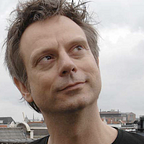Can Layar become an on-the-road-search tool?
You all know Layar of course, it can’t be missed. The new tool made by SPRX Mobile is as the say themselves ‘the first mobile augmented reality browser’. Next week there will be a first devcamp with Bruce Sterling setting the context. And that is interesting because I think the approach of Layar is showing different models for a new emerging augmented world.
The way SPRX Mobile approached the market gives the idea they heading for a role as enabler for mobile augmented services provides by content providers. Just like Wikitude they offer an of-the-shelve solution for building augmented apps on the Android, and soon also for the iPhone. Different to Wikitude is the attention to the user experience, both in interaction and visual information design.
But there is another important difference: Layar is positioned as a brand on its own, as a tool you should use if you are looking for augmented information. We have seen this happening before with the start of the mobile internet; i-mode of KPN was the portal to the mobile web.
I don’t think (and hope) however Layar wants to be the new i-mode. Of course it can be a leveraging strategy to open the marketplace of augmented content, which is happening right now with all the press attention. But in the end such propriety solutions with closed content are hard to make a success.
More interesting would it be if Layar could become a kind of on-the-road search tool. A start for finding answers to location based questions when you are on-the-road. All questions with the paradigm: Where around me can I find […] now?
In this question you find also the choice for the type of augmented approach. You can discuss what defines an application as augmented. It should add a virtual smart layer to the real world context. You can differ two axes. Object triggered vs. impulse driven, and remixing reality vs. adding context
- Object triggered, point and enrich: I see this object, point the mobile device to it and a layer with extra data out of the cloud is projected on the object. For example the TAT augmented ID app.
- Impulse driven: I want something to know, related to my position and find the information plotted on the reality.
- Remixing reality add a virtual representation of real content on the actual live footage and combine this to one reality. Think of the Tube finder.
- Adding context plots extra information based on your position and uses the real images to help you find the right directions.
It is clear that the current Layar app is positioned in the corner impulse driven/adding context. To be a successful service you should perform well on both elements of course.
- To fulfill the impulse as an on-the-road browser you want to have a complete search-experience. In every possible on-the-road search field there should be content. Therefor it is important to work together with content parties that offer localized complete content within one area. Like the ATM-finder that finds all ATM’s and not only the ones of one brand.
- To fulfill the adding context need it is important to add real valuable content for the location and the moment of use. The example of Funda for finding houses where you can filter and especially directly can connect with the seller of the property is.
In the ideal world an open model fill the search tool with all available content. The augmented Google. But the quality of the content and legal issues will give enough space for a more closed approach like Layar.
It will be however still a difficult road to make it a top-of-mind on-the-road search tool. Finding the right content partners with generic data and keeping strong focus on an user driven approach. Lets hope Layar is heading to become a successful on-the-road search tool.
